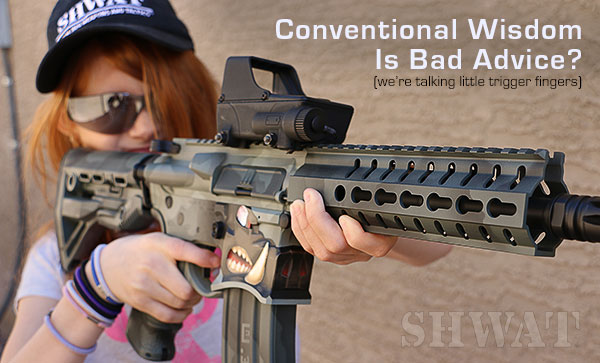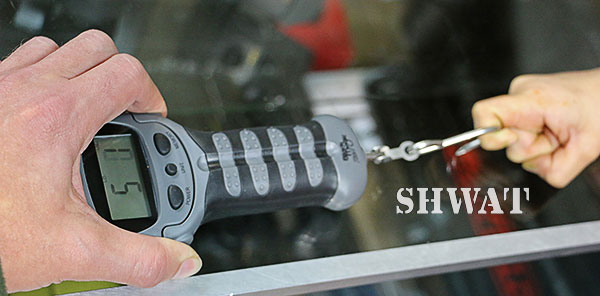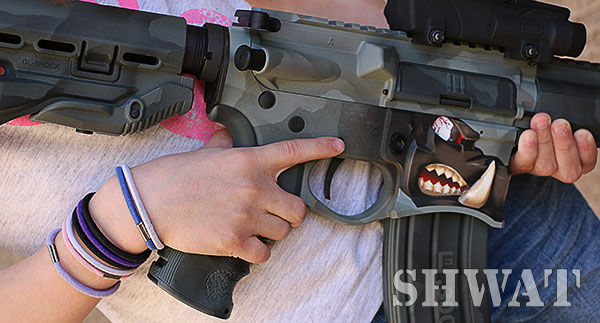
“Come outside,” I told her, “I want you to try something.” Conventional wisdom was about to unravel.
Several minutes later her small finger found the trigger, her eyes brightened behind the optic and a smile spread across her face. “I can shoot this now!” She exclaimed. “Can I please go shoot a pig now?!”
When teaching children to shoot, one of the most important considerations is the trigger. The trigger on a child’s firearm is much more critical than the trigger on an adult’s firearm. This is because of two main factors; strength and reach. A child is not as strong as an adult, and a child’s hand and finger are smaller.
Conventional wisdom says that a child should not be given a firearm with a light trigger. In fact, some manufacturers of child-sized single-shot .22 rimfire rifles install insanely heavy triggers as a “safety feature.” This is the wrong approach. A child should have a lighter trigger, not a heavier one. This is why I start my children off on one of Savage’s tiny single-shot .22s with the light, adjustable Accutrigger.
Watching my eight year old daughter struggle with a trigger that I felt was a fairly nice, 4 or 4.5 pound two-stage trigger brought a question to my mind. Just how much stronger is an adult’s finger than a child’s finger? A trip to a fly fishing shop to borrow a digital fish scale brought an answer.

With the first pad of the trigger finger on the hook of the scale, and my daughter’s arm held tightly against the counter to prevent her from pulling with her arm, I measured the strength of her trigger finger. With that finger, she was able to put about five pounds of pressure on the scale, up to eight pounds when she managed to get her wrist and arm involved. Her 5-year-old brother managed just over four pounds using all the strength in his isolated trigger finger.
I tested myself and found that I could comfortably pull 14.8 lbs average with the tip of my trigger finger. My numbers were higher if I pulled it with the joint of the finger in the way the kids did, but I wanted to test it as close to the way a trigger is pulled as possible.
These numbers are specific to these specific children, but they prove that we seldom take the correct approach to the interaction of a child with a trigger. Here is what we must conclude: Even a common four-pound trigger weight (which is lighter than many out there), will be too heavy for most smaller children to shoot well. If a child such as the five-year-old previously mentioned can find the strength to manipulate a 4 or 5 lb trigger, he will learn poor trigger technique as he struggles to make the rifle fire.
My eight-year-old daughter could comfortably pull a max weight of about 5 pounds. That was approximately 1/3 of the weight I could comfortably pull. That means that if you could imagine a 15 lb trigger, that is what a 5 lb trigger would feel like to her. For her to squeeze a 4 lb trigger would feel like a 12 lb trigger feels to me, and a 2.5 lb trigger, which most people would say is far too light for a child, would feel to her like a 7.5 lb trigger for an adult.
Using a heavy trigger for “safety” on a child’s firearm is the wrong approach. Not only is it unsafe because the child then struggles with the trigger, often using both hands, but it is impossible to teach good trigger control with a trigger that is too heavy. Consider some of the .22 youth rifles that have had triggers as high as 12 to 15 lbs in light of this finger strength test. They would be like handing an adult a rifle with a 36 to 45 lb trigger and expecting him to learn to shoot. I can’t shoot well with a 12 lb trigger. Can I expect a six-year-old to do what I cannot?
Children should be taught to shoot using the lightest trigger that is practical and safe. Safety should be taught, not built into the rifle in the form of a heavy trigger. We cannot build a rifle that is safe when used unsafely, but even a rifle that is mechanically unsafe cannot harm anyone if all safety rules are followed. So a mechanically sound rifle is only as safe as the person holding it. Teach safety at every opportunity until safety becomes an instinctive habit in the child’s life.
If your child will be shooting an AR-15, as my daughter was, a Timney trigger is a great idea. The Timney triggers drop in as a complete unit making for very simple installation. They are consistent from trigger to trigger, so if you have the same Timney triggers installed in several rifles, the trigger pull is exactly the same from rifle to rifle. Timney also makes drop-in triggers for most common hunting, sporting, and surplus rifles, so upgrading any of these rifles for use by a child is fast and simple.
I have used both single-stage and two-stage Timney triggers. I personally prefer single-stage triggers, but shoot with two-stage triggers often. On my daughter’s rifle, I chose a two-stage trigger as it is slightly lighter at 2 lbs, and I think it is good to teach a child the use of a two-stage trigger. (I know a man who lost a chance to shoot a trophy caribou because he was using an unfamiliar rifle with a two-stage trigger. After he squeezed the trigger through the first stage, he thought it failed to fire.) A two-stage trigger also adds a margin of safety as the trigger must travel through the first stage before the rifle can be fired.

The curved shape of the trigger bow on this particular trigger is advantageous for a child. It is easier to reach with small fingers, while still remaining comfortable for an adult with large hands. Timney offers several trigger bow styles, but I would recommend the solid curved style for most children.
So as far as I’m concerned, that’s the end of conventional wisdom when it comes to teaching kids to shoot. Don’t fall for the myths, and don’t let your friends with kids fall for it either. Set the kids up for success. Based on my experience, from now on Timney triggers will be my go-to triggers for any AR rifle intended for a child. I will continue to use them in my own rifles.


